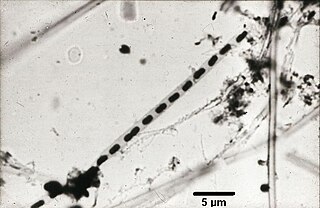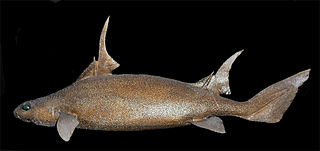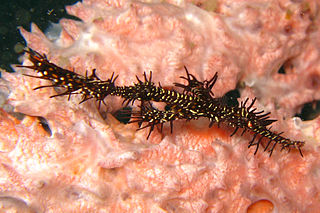
Pallas's sandgrouse is a medium large bird in the sandgrouse family named after the German zoologist Peter Simon Pallas. The scientific name is from Ancient Greek. The genus Syrrhaptes is from surrhaptos, "sewn together" and paradoxus is from paradoxos, "strange".

Dilong is a genus of basal tyrannosauroid dinosaur. The only species is Dilong paradoxus. It is from the Lower Cretaceous Yixian Formation near Lujiatun, Beipiao, in the western Liaoning province of China. It lived about 126 million years ago.

The Comamonadaceae are a family of the Betaproteobacteria. Like all Pseudomonadota, they are Gram-negative. They are aerobic and most of the species are motile via flagella. The cells are curved rod-shaped.

Helianthus paradoxus, the paradox sunflower, puzzle sunflower or Pecos sunflower, is a threatened species of sunflower found only in west Texas, Utah, and New Mexico salt marshes by the edges of inland salt lakes and salt flats.
Pulsus paradoxus, also paradoxic pulse or paradoxical pulse, is an abnormally large decrease in stroke volume, systolic blood pressure and pulse wave amplitude during inspiration. The normal fall in pressure is less than 10 mmHg. When the drop is more than 10 mmHg, it is referred to as pulsus paradoxus. Pulsus paradoxus is not related to pulse rate or heart rate, and it is not a paradoxical rise in systolic pressure. The normal variation of blood pressure during breathing/respiration is a decline in blood pressure during inhalation and an increase during exhalation. Pulsus paradoxus is a sign that is indicative of several conditions, including cardiac tamponade, chronic sleep apnea, croup, and obstructive lung disease.

Liaoningosaurus is an unusual genus of ankylosaurian dinosaurs from the Early Cretaceous period of China. It contains a single species, Liaoningosaurus paradoxus, and is represented by two fossil specimens collected from the Yixian Formation of Liaoning. L. paradoxus was unusual among advanced ornithischian dinosaurs in that it is speculated to have hunted or scavenged, with preserved gut contents showing that it may have eaten fish. Additionally, some features of its skeleton may suggest that it was partially aquatic.

The Hispaniolan solenodon is a small, furry, shrew-like mammal endemic to the Caribbean island of Hispaniola. Like other solenodons, it is a venomous, insect-eating animal that lives in burrows and is active at night. It is an elusive animal and was only first described in 1833; its numbers are stable in protected forests but it remains the focus of conservation efforts.

The sailfin roughshark is a species of dogfish shark in the family Oxynotidae, found in the eastern North Atlantic from Scotland to Senegal between latitudes 61°N and 11°N, at depths of between 265 and 720 m. Its length is up to 1.2 m (3.9 ft).
The Nicaraguan harvest mouse is a species of rodent in the family Cricetidae. It is found in Costa Rica and Nicaragua.

The five-toed pygmy jerboa is a species of rodent in the family Dipodidae. It is monotypic within the genus Cardiocranius. It is found in China, Kazakhstan, and Mongolia.

The ornate ghost pipefish or harlequin ghost pipefish, Solenostomus paradoxus, is a false pipefish of the family Solenostomidae. The species name comes from the Greek paradoxos, referring to this fish's unusual external features. Ornate ghost pipefish are found in the Western Pacific and the Indian Ocean along reef edges prone to strong currents from the Red Sea to Tonga. They reach a maximum length of 12 cm. They vary in color from red or yellow to black and are almost transparent. Although relatively common, ornate ghost pipefish are very well-camouflaged and difficult to find. It occurs either as solitary individuals or in pairs, among the branches of gorgonians, in floating weeds, or crinoids where the feed on mysids and small benthic shrimp.
The paradox vole is a species of rodent in the family Cricetidae found in southern Turkmenistan.
Austroperipatus is a genus of oviparous and ovoviviparous velvet worms in the family Peripatopsidae. The species in this genus are found in northern Queensland, Australia.
Saccharomyces paradoxus is a wild yeast and the closest known species to the baker's yeast Saccharomyces cerevisiae. It is used in population genomics and phylogenetic studies to compare its wild characteristics to laboratory yeasts.
Variovorax paradoxus is a gram negative, beta proteobacterium from the genus Variovorax. Strains of V. paradoxus can be categorized into two groups, hydrogen oxidizers and heterotrophic strains, both of which are aerobic. The genus name Vario-vorax and species name para-doxus (contrary-opinion) reflects both the dichotomy of V. paradoxus metabolisms, but also its ability to utilize a wide array of organic compounds.

Fukuivenator is an extinct genus of coelurosaurian theropod dinosaur from the Early Cretaceous of Japan.
Austroperipatus paradoxus is a species of velvet worm in the Peripatopsidae family. This species has 15 pairs of legs.

Xanthostemon paradoxus, commonly known as bridal tree or northern penda, is a shrub or tree species in the family Myrtaceae that is endemic to Australia.

Metoecus paradoxus, also known as the wasp nest beetle and eyelash bug, is a species of Metoecus in the family Ripiphoridae.
Ancistronychus is an extinct genus of drepanosaur from the Late Triassic Petrified Forest National Park in the Chinle Formation of Arizona. The type and only known species is Ancistronychus paradoxus, from Ancient Greek to mean "unexpected fishhook claw" due to its characteristic hooked shape. Ancistorhynchus is only known from a collection of isolated large claws from its second fingers, a distinctive trait of other derived drepanosaurs. Ancistorhynchus is characteristic amongst drepanosaurs by the strongly hooked shape of its claw, which is shorter in height and broader than those of Drepanosaurus, and is flat at its tip. The claw is also cleft at its tip, a trait found in living animals that use their claws for digging, such as moles and pangolins, by providing a larger attachment area for the keratin sheath of the claw. Likewise, functional analyses of its claws compared to other drepanosaurs and various living animals indicates that Ancistronychus used its large claw for digging underground, perhaps even for burrowing.













